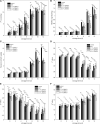Effect of pepper (Zanthoxylum bungeanum Maxim.) essential oil on quality changes in rabbit meat patty during chilled storage
- PMID: 35068562
- PMCID: PMC8758852
- DOI: 10.1007/s13197-021-04998-6
Effect of pepper (Zanthoxylum bungeanum Maxim.) essential oil on quality changes in rabbit meat patty during chilled storage
Abstract
In this paper, the components of Zanthoxylum bungeanum Maxim. essential oil (ZBMEO) were analyzed. The efficacy of different concentrations of ZBMEO on the change in physical and chemical indicators of the rabbit meat patty was evaluated. Furthermore, kinetics models were employed to calculate the lipid oxidation induction period and microbial growth lag time. GC-MS analysis revealed that the major chemical components in ZBMEO included linalool, limonene, and sabinene. Results of the storage experiment indicated that ZBMEO had a good inhibition effect on lipid and protein oxidation, microbial growth, and formation of TVB-N, as well as slowed down the rate of change in color and pH during the 12 days storage time of rabbit meat. The models showed that adding ZBMEO could delay the lipid oxidation induction period, and extend the microbial growth lag time. Overall data showed that ZBMEO is a promising natural additive to maintain the quality of rabbit meat patty.
Keywords: Kinetic models; Lipid and protein oxidation; Quality index; Rabbit meat; Zanthoxylum bungeanum maxim. essential oil.
© Association of Food Scientists & Technologists (India) 2021.
Conflict of interest statement
Conflicts of interestAuthors declare that there is no conflict of interest.
Figures



References
-
- Aminzare M, Tajik H, Aliakbarlu J, Hashemi M, Raeisi M. Effect of cinnamon essential oil and grape seed extract as functional-natural additives in the production of cooked sausage-impact on microbiological, physicochemical, lipid oxidation and sensory aspects, and fate of inoculated Clostridium perfringens. J Food Saf. 2018;38(4):e12459. doi: 10.1111/jfs.12459. - DOI
-
- Cairo PLG, Gois FD, Sbardella M, Silveira H, De Oliveira RM, Allaman IB, Cantarelli VS, Costa LB. Effects of dietary supplementation of red pepper (Schinus terebinthifolius Raddi) essential oil on performance, small intestinal morphology and microbial counts of weanling pigs. J Sci Food Agric. 2017;98(2):541–548. doi: 10.1002/jsfa.8494. - DOI - PubMed
-
- Chang W, Liu F, Sharif HR, Huang Z, Goff HD, Zhong F. Preparation of chitosan films by neutralization for improving their preservation effects on chilled meat. Food Hydrocoll. 2019;90:50–61. doi: 10.1016/j.foodhyd.2018.09.026. - DOI
LinkOut - more resources
Full Text Sources
Miscellaneous
